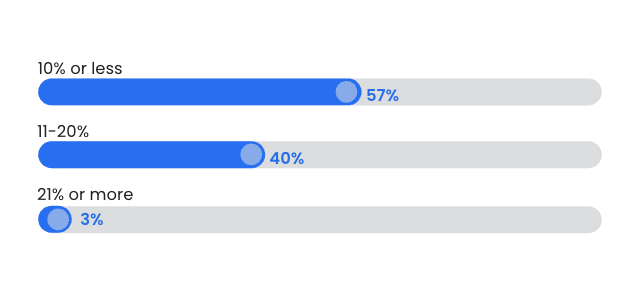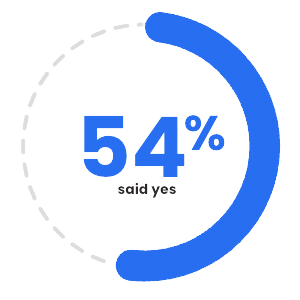1ST EDITION
The State of Moving and Storage
Insights from over 100 moving companies
managing 1000s of moves per year

Executive Letter
I’ve moved over 19 times, and experienced my fair share of challenging moves. Through that, I started to wonder about the complexities that exist on the movers’ side of the equation that can make or break the customer experience.
We started Supermove during COVID—a time that has presented both challenges and opportunities for moving companies. Over the past few years, demand has risen for moving services but labor shortages and COVID safety protocols have forced movers to get creative and adopt new ways of working. Our goal is to create a system that helps entrepreneurs like you in this space organize and grow your business and provide a better consumer moving experience.
The inspiration for this report came from the same place—we wanted to better understand the state of the moving industry as Americans continue to adjust to COVID and the US faces new economic challenges. Moving companies have gone through significant transformations over the last few years, and we were curious to get a pulse on what 2023 will look like.
I hope you find the first edition of the State of Moving and Storage report full of helpful trends and benchmarks and are able to use this information to understand and grow your business over the coming year.
Wonjun Jeong
CEO, Supermove

Survey respondent firmographics
Role
Owner
52%
Executive
21%
Office manager
20%
Other
7%
2022 revenue
$0-$999K
31%
$1M-$1,999,999
24%
$2M-$4,999,999
21%
$5M-$9,999,999
11%
$10M+
11%
Number of trucks
0
5.63%
1-9
57.75%
10-19
16.90%
20-29
2.82%
30+
16.91%
Number of moves per year
Less than 999
38%
1000-1999
32%
2000-2999
6%
3,000-4,999
13%
5,000+
10%
Average price per move type
Residential
$1,600
Residential long distance
$4,000
Commercial
$3,500
Interstate
$8,000
Military
$3,000
International
$7,500
Types of moves

Do you offer storage?


Survey respondent firmographics
Arizona
1%
California
21%
Colorado
1%
Florida
10%
Illinois
1%
Kansas
1%
Kentucky
1%
Maryland
3%
Massachusetts
3%
Michigan
1%
Missouri
3%
Montana
1%
New Hampshire
3%
New Jersey
3%
New York
10%
North Carolina
1%
Ohio
4%
Oklahoma
1%
Pennsylvania
6%
Rhode Island
1%
South Carolina
1%
South Dakota
3%
Tennessee
3%
Texas
3%
Utah
1%
Vermont
1%
Virginia
1%
Washington
4%
Wisconsin
1%

INTRODUCTION
The past 20 months have been, in a lot ofways, a great run for the moving industry.With housing market booms and deurbanization driven by COVID-19, moversnationwide have barely been able to keepup with the demand. But with inflation,surging interest rates, falling housing prices,and a looming recession, 2023 is ushering inmacroeconomic factors that are impactingindividual households, and by proxy, movingcompanies.That said, the moving industry is uniquelyplaced to handle volatile economic times—the industry already experiences hugeseasonal swings, and moving companiesknow how to flex their resources to weatherthe ups and downs in their businesses. Plus,new tools and resources are increasinglyavailable that make it easier for customersto access local movers and for movers tohandle larger, more ambitious projects.
Do you offer storage?
- The expansion of the housing market has positivelyaffected industry operators
- The pandemic hurt businesses, and slowed downdemand for movers from corporate customers
- An increase in nonresidential construction is expectedto increase demand for moving services
- Big cities will continue to be the most active areas for moving services
- Competition and acquisition activity will continue to characterize the industry

Search trend data for consumer moving terms in the US between 2018 and 2022

Focal areas for moving companies
Diversity
Moving companies should have a range of typesof clients to limit seasonal volatility. These clientscan range from individuals to corporations and thepublic sector.
Reputation
Moving is stressful! Consumers are looking towork with moving companies that will helpalleviate stress on move day, make the processefficient, not have hidden fees, and take care oftheir possessions. Companies that have a greatreputation are more likely to win new business andhave repeat customers.
Capacity
Because of the low profit margin in the industry, managing capacities–of workers, trucks, and storage units–is key for growth. Ensuring that you’re not over or under booked will contribute to profitability.
Accessibility
It may seem obvious, but being able to serve theneeds of customers is key to growth. Accessibilitycan come down to following up quickly oncustomer queries, to being part of the van line soyou can help customers, regardless of the size oftheir move.

CHAPTER 01
Challenging financial times lie ahead but movers are still planning for growth
Movers are resilient and the moving industry is a more secure place to be in a recession than a lot of other businesses because of the existing rhythms in this industry—going from high to low every year, with summers being busy and things slowing down again in September. Movers are used to ramping up and ramping down and already knowhow to prepare balance sheets, how to stay liquid, and how to take care of core staff.That being said, growth will be complicated in 2023 by access to movers and drivers—the top challenge for moving companies this year. Economic recession and rising costs come in second and third, respectively


Of those that believe we are in a recession, 73% still believe they will bring in the same or more revenue in2023 than in 2022.
Movers’ 2023 goals
- Grow bottom line (profit)
- Grow top line (revenue)
- Break-even
- Other
Movers’ top challenges
- Talent acquisition &management
- Recession
- Rising costs
- Government Regulations
- Operational efficiency
- Asset management
Shifts in the residential housing market will add pressure on the moving industry in the coming years—while the market boomed between 2018-2022, it’s expected to slow over the next few years. This, coupled with a looming recession (72% of survey respondents say they believe the USA is already in a recession) will make residential moving a more turbulent business than it has been in recent years.But despite financial uncertainty, moving companies are prioritizing the bottom line and still planning to grow profits in 2023.

69% of movers are planning to mitigate their challenges by increasing prices

By how much?

How movers are planning on spending budget in 2023

CHAPTER 02
Movers are looking to diversification as the top growth strategy in 2023
While higher prices will help somewhat when it comes to maintaining margins, movers will need to get more aggressive if they want to grow. 42% of survey respondents indicated that their 2023 goal is to grow profit, while34% said their goal is to grow revenue.Expanding via new offerings, diversification of move type, and reducing costs will dominate as the top growth strategies in 2023.Diversifying, both in terms of offerings and move type is a great way to mitigate some of the volatility that we see in the moving industry.



Strategies to Achieve 2023 Goal
- Expand via new offerings (eg, storage, packaging, etc)
- Reduce costs
- Diversification of move type
- Increase marketing budget or expand to new regions
CHAPTER 03
More companies are moving towards paid marketing efforts
Over the past couple of years, moving companies have enthusiastically adopted digital marketing as a way to reach new customers and expand their business. This has been supported by sites like Moversville that are dedicated to providing great resources, as well as free software and tools—everything from Facebook to Hubspot. According to our survey, referral partners are by far the most effective marketing tactic for movers, with survey respondents saying they generate the highest quality leads. Paid search is a close second, as more moving companies work to capture business online.
Do you do paid marketing?

Of those that do, do it via:

Respondents were split on what 2023 looks like for marketing budgets. We did see a correlation between marketing spend and respondents that said they wanted to grow top line, with 33% saying they anticipate spending more on marketing in an attempt to gain more customers. 45% expect spending to look more or less the same as in 2022. 13% indicated that they were unsure, while only 8% of respondents expect to spend less to market their business in 2023.
Focal areas for moving companies
What channels do you invest in?
Which channels generate the highest quality leads?


CHAPTER 04
Brand and organic effort will be key for movers looking to keep marketing budgets steady
For those looking to expand their business without a significant increase in marketing investment, brand and reputation will continue to be important levers in 2023.Channels like social media and community events will rarely generate leads directly—we saw this in our survey findings—but their indirect impact for your business can be significant. These are great, free ways to engage with your community, build trust, and amplify your brand so that when a customer needs a mover, your company is top of mind.
4 free lead sources
• Referrals or word-of mouth
• Search engine optimization
• Blogs
• Social media
Focal areas for moving companies
The best way to get referrals is to become an active member of your community. Join networking groups and build real relationships with other community leaders through organizations such as:
• Local Chamber of Commerce
• Local Business Improvement Areas (BIA)
• Local BNI chapter
• Realtor associations and real estate agencies
• Young Entrepreneur Council
• Regional Convention, City and Visitors Bureau*
• Merchant associations
• Meetups (find events online)
Search engine optimization (SEO)
Make sure your business is always the first to pop up when someone Googles moving services in your area.SEO has a lot of moving parts and should be incorporated into all your website’s pages – home page, landing pages, blogs, etc. This helps ensure the best results.(backend SEO, on-page SEO, off-site SEO, paid SEO, local/regional SEO, backlinks, etc.) According to BrightEdge’s research, 53.3% of website traffic across industries comes from organic search.
* Find out what events are happening in your community so you can become either a sponsor through either financial or in-kind donations.
Blogs
When a potential customer is looking for information, finding an article on your website can be helpful.Having informative and educational content on your website in the form of a blog is what starts to build relationships with potential customers. Consider writing blogs to help people understand what they need to know before a move, what a move can cost, neighborhood information, and FAQs.
Social media
Almost every business is on social media these days.But the key is making sure you post regularly and trulybuild a community with your followers. Aside fromregular updates, this means responding to comments,answering questions and DMs, and interacting withother accounts as well.

CHAPTER 05
Talent acquisition and management remain the#1 challenge for movers
The moving industry as a whole will continue to struggle with talent management.However, nearly 50% of survey respondents still plan to increase headcount in 2023, meaning competition for talent will be ferocious. Moving companies will need to carefully consider how they’re finding, hiring, onboarding, and retaining talent so as not to waste money on new employees, only to have them leave after a short time.Investing in people and culture will be one of the top ways that companies can standout in the hiring market. Additionally, moving companies should look to other industries to hire—as we move through an economic slow down, movers can take advantage of layoffs in other industries to add fresh perspectives to their organizations.
Full-time staff: Office

Full-time staff: Crew

In 2023, movers need to get innovative about hiring and create people-first cultures to stay competitive
Hiring
Proactively look for top talent even in tough economic times. And don’t be afraid to put in the time to listen to them, understand what they like and what their goals are, and build a common bond to connect with them.

I’ve bought into the mindset of alwayslooking for good talent, so I think there’s asilver lining here…When things pick backup again we’ll have the cream of thecrop—we’ll have crews and trucks readyto go to address the volume of business.
Paul Woodruff, Owner, Brothers Moving
Think outside the box and hire beyond your industry. There’s plenty of talent outside of the moving sector.
Hire based on attitude, values, and heart—experience isn’t everything

I’ve bought into the mindset of alwayslooking for good talent, so I think there’s asilver lining here…When things pick backup again we’ll have the cream of thecrop—we’ll have crews and trucks readyto go to address the volume of business.
Paul Woodruff, Owner, Brothers Moving
Ask for referrals from existing employees
Innovate in the hiring process

Do you hire additional labor during peak season?

Movers’ top challenges


INNOVATIVE HIRING
Improving retention in your hiring funnel
Overview
With his strong leadership and a team aligned around a shared vision, Lorne MacInnes, President and CEO ofFerguson Moving & Storage, rapidly grew his business into a Canada-wide franchise. However, he saw that they were losing people in their hiring funnel and recognized the need to change their approach. What if they started treating their first meeting with candidates not like an interview, but like an orientation?
Approach
“You have 10 people show up and then we run through a script of welcome to the company, give a little bit of history, talk about what we do, we give examples of people that have risen in the company from being a mover to being a franchise owner, or working in the trucks and now they’re in operations, or getting into sales positions, and talking about the different salaries that these people earn,” says Lorne.“Then we also talk about the difficulties of the job, like lots of overtime, different start times, working in inclement weather, heavy lifting, and stuff like that. And then we asked everybody there, if you’re still interested, we’ll meet one-on-one with each of you. And for those of you who are still here, there are refreshments, there’s coffee and water, and remember this is paid time. If you feel this isn’t for you, feel free to withdraw your application and we’ll pay you for the time that you came in today.”
Retaining
Differentiate yourself based on culture and build a strong culture that people want to be part of. This can include every thing from offering paid vacation, 401ks, and guaranteed hours, to how you manage recognition and even conflict internally.
Invest in employee training anddevelopment.
Recognize people and show appreciation for good work.
Provide advancement opportunities for staff.
Invest in tech that encourages flexibilityand helps movers and drivers achievework-life balance.
CHAPTER 06
The moving industry is going through active digitization
Moving companies–especially those planning for growth in 2023–should consider adding an all-in-one system to their tech stack for the following reasons:
Strategies to Achieve 2023 Goal
Moving companies–especially those planning for growth in 2023–should consider adding an all-in-one system to their tech stack for the following reasons:
Get hours back in your week with better organization and efficiency
There are a thousand different ways that moving management software helps you save time on your day-to-day tasks:Digital calendars, estimates, bills of lading, inventory sheets, and more make it easy to complete admin in minutes instead of hours.

of respondents said they currently use some kind of software to manage the business.

Improved customer experiences and reputation
Software can help maintain your great reputation in a few ways:
- Capturing, processing, and following up with leads quickly and easily
- Digitally managing estimates, quotes,and all client communication
- Getting customer sign-off on quotes, etc., with e-signatures
- Giving your customers visibility into where their stuff is on move day
- Enabling easy payment right in the app
- Setting up automatic email triggers asking for a review once a move is complete
Security and availability
SaaS moving software stores your information securely in the cloud. Your vendor manages security (and will have security experts on staff to manage it properly) plus your data is always available, anywhere from any device.
While accounting, scheduling, and CRM solutions are widely used in the industry, there is still room for growth for all-in one solutions (a single comprehensive system that acts asCRM, scheduler, task management, payment system, etc).

of respondents said they plan to purchase software in 2023...

...and a majority of those are planning to buy an all-in-one moving management solution like Supermove.
Cost savings
Software saves you on paper costs, hiring, and having to correct math mistakes like billing errors and missing overnight chargers, and other clerical errors that can cost your company thousands of dollars.
Ease of use
Moving software that’s intuitive and easy to use for everyone on your team helps you feel confident you’re capturing all the information you need to get a full picture of your business performance.
Constant innovation
Cloud-based moving software vendors are constantly working with movers like you to understand what updates and new features need to be built. This innovation is part of the package when you choose to partner with a SaaS vendor and will keep you ahead of the curve (and ahead of your competitors).

What kind of software do you currently use?

If you plan on purchasing software in 2023, what kind?

LOOKING FORWARD
Invest in community and skills development to take advantage of opportunities
There are a lot of unknowns facing the moving industry over the next year, but movers are feeling optimistic about their opportunities for growth. There is a great community in this industry—technology partners, consultants, community associations and even competitors can all contribute expertise to help mover not just survive but thrive over the next 12 months. Movers should also consider skill development in order to keep pace with an industry that’s becoming increasingly digital and data-based. Hard skills will need to be balanced with soft skills like empathy in order to continue building the strong relationships that movers need to keep customers coming back.
Skills to develop in 2023:
- Data literacy
- Financial literacy
- Technology literacy
- People & culture-building skills
- Networking and community engagement

